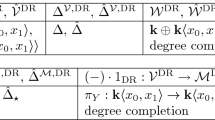Abstract
We derive from the compatibility of associators with the module harmonic coproduct, obtained in Part I of the series, the inclusion of the torsor of associators into that of double shuffle relations, which completes one of the aims of this series. We define two stabilizer torsors using the module and algebra harmonic coproducts from Part I. We show that the double shuffle torsor can be described using the module stabilizer torsor, and that the latter torsor is contained in the algebra stabilizer torsor.
Similar content being viewed by others
Notes
The statements of [4], §2.4 rely on the statement from loc. cit., §2.4.1 that there is an isomorphism of graded algebras \(\mathrm {gr}({\mathcal {V}}^{\mathrm {B}}){\mathop {\rightarrow }\limits ^{\sim }}{\mathcal {V}}^{\mathrm {DR}}\) induced by \([X_i-1]\mapsto e_i\) for \(i=0,1\), which is proved in [4] by quoting reference [Bou] from loc. cit.. This quotation does not prove the claimed statement. A correct proof can be done by applying the functor \(\mathrm {gr}\) to the isomorphism of filtered algebra \(\varphi \) from [8], Example A2.11, S being equal to the set \(\{0,1\}\) and K to \({\mathbb {Q}}\), and then tensoring the resulting isomorphism with \({\mathbf {k}}\).
The definition of the right action of \({\mathbf {k}}^\times \subset {\textsf {GRT} }({\mathbf {k}})\) on \({{\textsf {M} }}({\mathbf {k}})\) given by \((\mu ,\varphi )\cdot c=(\mu /c,\varphi (A/c,B/c))\) (p. 852) does not appear to be compatible with the definition of the group structure on \({\textsf {GRT} }({\mathbf {k}})\) as the semidirect product of \({\textsf {GRT} }_1({\mathbf {k}})\) with the action of \({\mathbf {k}}^\times \) by \((c\cdot g)(A,B):=g(A/c,B/c)\) ( [2], p. 851), since these formulas lead to \((((\mu ,\varphi )\cdot c)\cdot g)\cdot c^{-1}= (\mu ,\varphi )\cdot (c^{-1}\cdot g\cdot c)\). This compatibility is restored, and Proposition 5.5 in [2] is correct, if the right action is defined by \((\mu ,\varphi )\cdot c=(c\mu ,\varphi (cA,cB))\); we work with this convention.
The map \((-)\cdot 1_{\mathrm {DR}}:\hat{{\mathcal {V}}}^{\mathrm {DR}}\rightarrow \hat{{\mathcal {M}}}^{\mathrm {DR}}\) is not compatible with the coproducts \({\hat{\Delta }}^{{\mathcal {V}},{\mathrm {DR}}}\) and \({\hat{\Delta }}^{{\mathcal {M}},{\mathrm {DR}}}\), so that this map does not induce a group morphism \({\mathcal {G}}(\hat{{\mathcal {V}}}^{\mathrm {DR}})\rightarrow {\mathcal {G}}(\hat{{\mathcal {M}}}^{\mathrm {DR}})\).
References
Alekseev, A., Torossian, C.: The Kashiwara–Vergne conjecture and Drinfeld’s associators. Ann. Math. 175, 415–463 (2012)
Drinfeld, V.: On quasitriangular quasi-Hopf algebras and a group closely connected with \({\rm Gal}(\overline{{{\mathbb{Q} }}}/{{\mathbb{Q} }})\). Leningrad Math. J. 2(4), 829–860 (1991)
Enriquez, B., Furusho, H.: A stabilizer interpretation of double shuffle Lie algebras. Int. Math. Res. Not. IMRN 22, 6870–6907 (2018)
Enriquez, B., Furusho, H.: The Betti side of the double shuffle theory. I. The harmonic coproduct. Selecta Math. (N.S.) 27(5), Paper No. 79, 106 pp (2021)
Furusho, H.: Double shuffle relation for associators. Ann. Math. (2) 174(1), 341–360 (2011)
Giraud, J.: Cohomologie non abélienne. Die Grundlehren der mathematischen Wissenschaften, Band, vol. 179. Springer, Berlin (1971)
Hochschild, G.: Basic Theory of Algebraic Groups and Lie Algebras. Graduate Texts in Mathematics, vol. 75. Springer, Berlin (1981)
Quillen, D.: Rational homotopy theory. Ann. Math. (2) 90, 205–295 (1969)
Racinet, G.: Doubles mélanges des polylogarithmes multiples aux racines de l’unité. Publ. Math. Inst. Hautes Études Sci. 95, 185–231 (2002)
Serre, J.-P.: Cohomologie Galoisienne. Lecture Notes in Mathematics, vol. 5, 5th edn. Springer, Berlin (1994)
Acknowledgements
The collaboration of both authors has been supported by grant JSPS KAKENHI as well as HighAGT ANR-20-CE40-0016.
Author information
Authors and Affiliations
Corresponding author
Additional information
Publisher's Note
Springer Nature remains neutral with regard to jurisdictional claims in published maps and institutional affiliations.
Rights and permissions
Springer Nature or its licensor (e.g. a society or other partner) holds exclusive rights to this article under a publishing agreement with the author(s) or other rightsholder(s); author self-archiving of the accepted manuscript version of this article is solely governed by the terms of such publishing agreement and applicable law.
About this article
Cite this article
Enriquez, B., Furusho, H. The Betti side of the double shuffle theory. II. Double shuffle relations for associators. Sel. Math. New Ser. 29, 3 (2023). https://doi.org/10.1007/s00029-022-00807-w
Accepted:
Published:
DOI: https://doi.org/10.1007/s00029-022-00807-w



